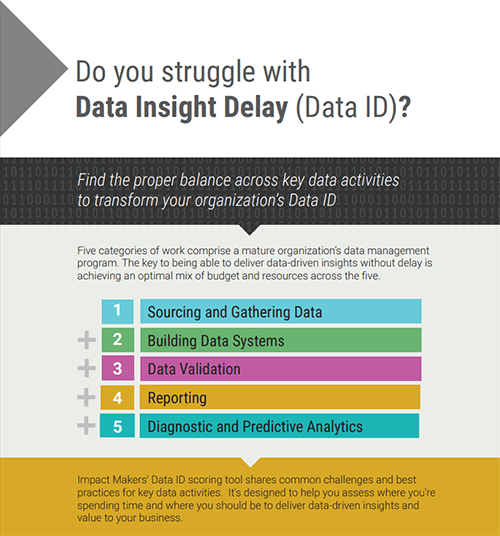
Across all industries, the race is on for firms to differentiate with data — through data-driven products; enhanced customer acquisition and experience; reduced risk; or streamlined operations (cost-out). C-suite executives have the aspiration and vision to win with data-driven insights, yet most are dissatisfied with the cycles consumed in producing data-driven insights. The time it takes for a business to deliver a quantitative insight from when an internal stakeholder or external customer needs it — let’s call that a firm’s Data ID, short for Data Insight Delay.
- Your digital product owner needs a data store from which to build a segmentation campaign to launch asap. How long is the Data ID: one month, 3, 6, or 12?
- Your CFO asks for a different slice of a standard canned report. What’s your Data ID: one hour, one day, one week, one month?
- A federal regulator issues a requirement for expected loan portfolio loss reporting. What’s your Data ID (let’s use labor hours this time): 40 hours, 400 hours, or 4000?
Data volumes are increasing exponentially, and business intelligence solutions are powerful and easier-to-use. But now more than ever, our bottleneck is the span between data production and data consumption. Wasted productivity and slow speed-to-market are certainly consequences of a high Data ID, and even more damning are the lost insights that are time-bound, as explained in Forrester’s thesis on Perishable Insights.
The target Data ID will vary based on your use case and your baseline, but we should prioritize which business scenarios will bring highest ROI with modern data investment. The wrong way is to merely apply more staff to reduce the Insight Delay, or to expect a new technology to be a silver bullet to an improved Data ID. Developing data pipelines add no business value if there isn’t well-governed processes to consume the data out of the lake and into the hands of a businessperson with a problem to solve or question to answer.
Firms that succeed with data take a holistic approach to both data strategy and technology. Modern data technology capabilities must be aligned to quantifiable customer and business objectives, and agreed operating and data governance models must be established. From there, use iterative development to take advantage of modern and emerging data technology solutions. Your strategic roadmap should prioritize improved Data ID for the use cases that have the highest business impact, with incremental gains along the journey as architectures are modernized and new data solutions are integrated.
For the full Impact Makers Data ID playbook, check out our free infographic, or contact us.
By Adam Foldenauer, Financial Services Vertical Lead
With nearly 20 years of experience in financial services and IT consulting disciplines, Adam Foldenauer is a customer-focused account executive and trusted adviser to clients in the banking, mortgage, insurance and financial services sectors.

